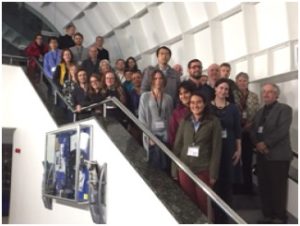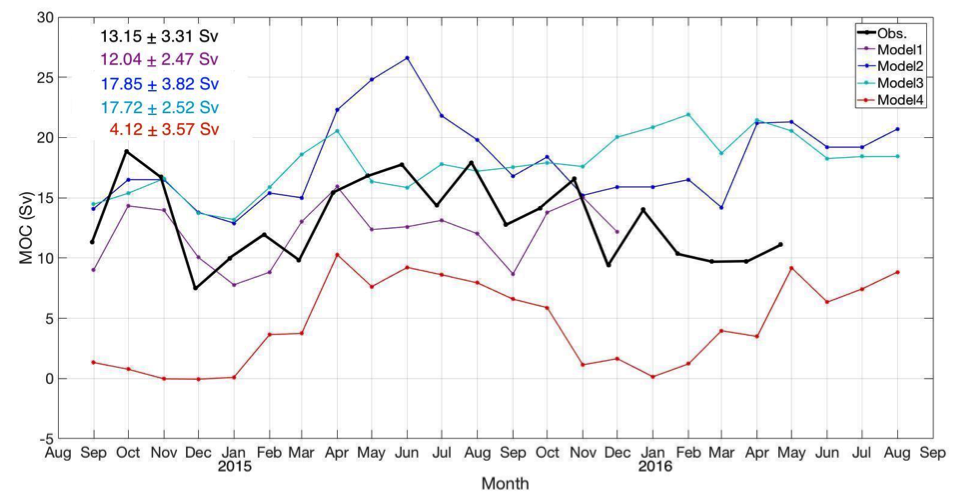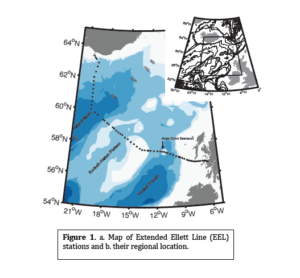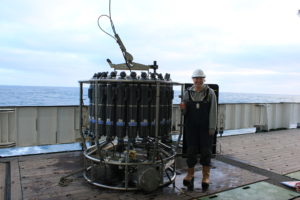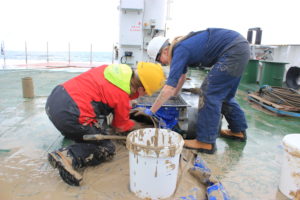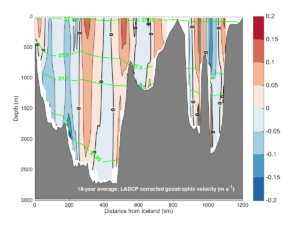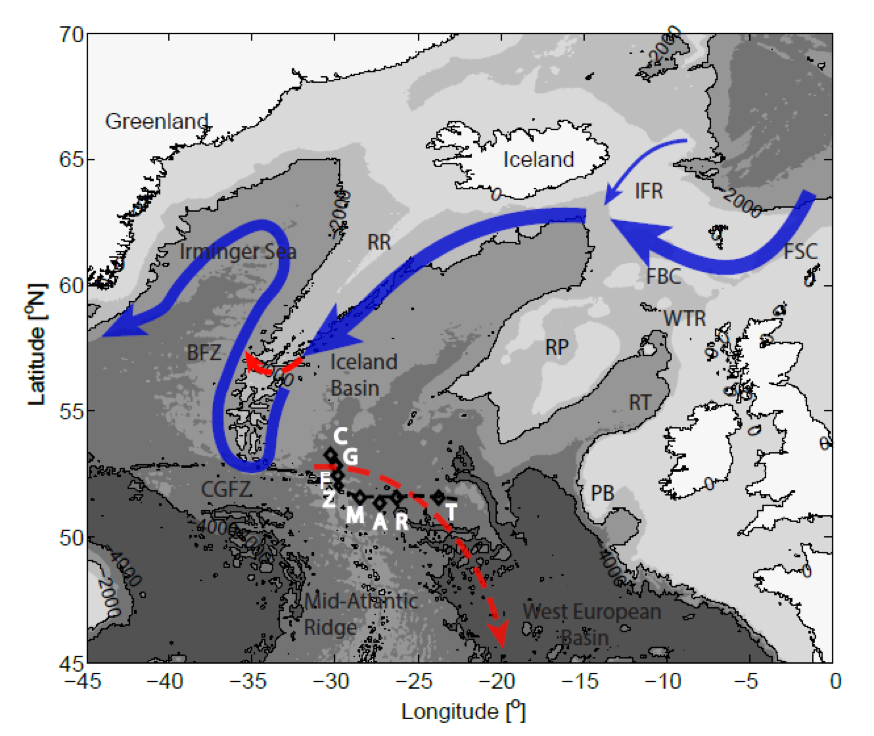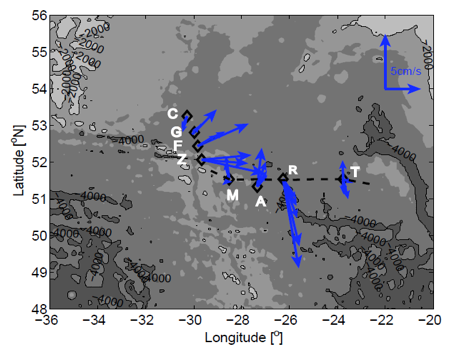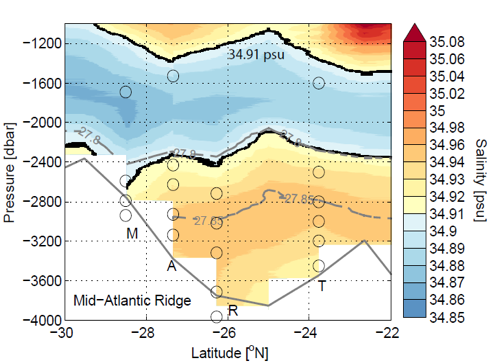OSNAP related talks at Ocean Sciences 2018
Monday, February 12, 2018; 4:00 PM – 6:00 PM
Oregon Convention Center; Poster Hall
PL14A-1754: Labrador Sea Water formation and its relationship to buoyancy forcing
Anastasia Romanou, M Susan Lozier, Feili Li, Kayla Rosann Flynn, Maria Aristizabal-Vargas and Joy Romanski
Tuesday, February 13, 2018 – Location: C123-C124
08:00 AM – 08:15 AM
Observational Evidence of Multi-Decadal Changes in Arctic Freshwater Transport to the Subpolar North Atlantic(HE21A-01)
Cristian Florindo-Lopez, Naomi P Holliday, Sheldon Bacon, Yevgeny Aksenov and Eugene Colbourne
Abstract: Changes in freshwater transport into the subpolar North Atlantic have the potential to disrupt or enhance the formation of dense water with subsequent impact on the meridional overturning circulation and associated ocean heat transport. Freshwater budget components in the subpolar North Atlantic include input from the atmosphere (precipitation vs evaporation, and river run-off), Greenland ice-sheet melt, saline subtropical water carried by the MOC, the dense overflow waters, and Arctic-origin freshwater carried by the shallow boundary currents that follow pathways west and east of Greenland. In this analysis we use a multi-decadal data set from the Labrador Shelf to characterise long-term variability in the transport of Arctic freshwater in the Labrador current. We first present evidence from an eddy-permitting global ocean circulation model to determine the origins of the water sampled by our time series. In particular we examine the dynamics of the currents on the Labrador Shelf in order to isolate the Arctic-origin water masses. We describe how we derive a 65-year record of changing Arctic freshwater transport from the observational data set. We will show that the multi-year changes in freshwater transport in the Labrador Current are consistent with independently-observed changes in subpolar freshwater storage.
Tuesday, February 13, 2018 – Location: B113-B115
08:30 AM – 08:45 AM
First Results from OSNAP: Overturning in the Subpolar North Atlantic Program(PL21A-03)
M Susan Lozier
Abstract: An international effort, Overturning in the Subpolar North Atlantic Program (OSNAP), is a partnership among oceanographers from the US, UK, Germany, the Netherlands, Canada and China whose goal is to measure and understand what drives the Atlantic Meridional Overturning Circulation (AMOC) and its variability. With high-resolution mooring arrays from the Labrador coast to the Scottish shelf, OSNAP provides a continuous record of the full water column, trans-basin fluxes of heat, mass and freshwater in the subpolar North Atlantic and has been operational since 2014. Data from the first 21 months of the full OSNAP observing system has been used to produce the first continuous time series of these variables. In addition to these time series, time mean estimates for all fluxes and attendant uncertainties will be presented, along with comparisons with other contemporaneous AMOC measurements and a discussion of subpolar overturning variability.
08:45 AM – 09:00 AM
Subpolar North Atlantic overturning and gyre circulation and heat and freshwater fluxes from two OSNAP high resolution hydrographic sections in the summers of 2014 and 2016 (PL21A-04)
Naomi P Holliday, Brian A. King, Stefan Gary, Stuart A. Cunningham, Johannes Karstensen, Elaine McDonagh, Sheldon Bacon, Feili Li and King Brian
Abstract: The international observational program, OSNAP (Overturning in the Subpolar North Atlantic Program) began in the summer of 2014 for the purpose of recording continuous trans-basin observations of volume, heat and freshwater. OSNAP will investigate the complex interplay between AMOC and gyre circulation, air-sea fluxes and ocean heat and freshwater transport convergence which presently lack observational evidence. The OSNAP array uses moored instruments, gliders and floats to measure velocity, temperature and salinity along a section from Canada to Greenland to Scotland. Here we present detailed views of the full-depth properties and velocity field from two high resolution hydrographic sections along the OSNAP line taken at the start of programme in June-July 2014 and during mooring turnaround cruises in May-August 2016. We derive estimates of the meridional overturning and gyre circulation and their components of heat and freshwater flux, finding that while the overturning dominates the heat flux, the freshwater flux is predominantly carried by the gyre. We show a notable difference in the magnitude of the overturning circulation and the heat and freshwater fluxes as measured by the two synoptic sections, and discuss how this relates to the associated differences in temperature, salinity and density fields.
09:00 AM – 09:15 AM
Transport of the Iceland-Scotland Overflow plume along the eastern flank of the Reykjanes Ridge (PL21A-05)
William E Johns, Adam Houk, Greg Koman, Amy S Bower, Sijia Zou and Susan Lozier
Abstract: Since 2014, an array of current meters deployed as part of the OSNAP trans-basin observing system has provided new measurements of the southward flow of Iceland-Scotland Overflow water (ISOW) along the eastern flank of the Reykjanes Ridge in the Iceland Basin. The location of the array, near 58°N, captures the ISOW Deep Western Boundary Current at the farthest downstream location in the Iceland Basin before significant amounts of ISOW can flow into the Irminger Basin through deep fractures in the Reykjanes Ridge. The transport of the ISOW plume at this location – based on the first two years of OSNAP observations (July 2014 to July 2016) – is 5.8 ± 0.9 Sv for ?? >27.8. Most of this transport is carried in a main branch of the plume along the upper ridge crest in depths from 1400-2200 m. A secondary branch in depths of 2400-2700 m along the lower ridge crest carries about 1 Sv. The transport of the ISOW plume varies over a considerable range, from about 2-10 Sv on weekly to monthly time scales (std. dev. = 2.4 Sv); however the mean currents from two individual year-long deployments are very similar and indicate a robust mean flow structure. Watermass analysis of the plume from continuous temperature/salinity measurements shows that about 50% of the plume transport (2.6-3.0 Sv) is derived from pure Norwegian Sea Overflow waters (NSOW) – consistent with the amount of NSOW known to be flowing over the northern sills into the Iceland Basin – while the remainder is made up of approximately equal parts of entrained Labrador Sea Water and modified Atlantic thermocline waters. The observed ISOW transport at this location is larger by almost 2 Sv than previous values obtained farther north in the Iceland Basin, suggesting that either additional entrainment into the ISOW plume occurs as it approaches the southern tip of the Reykjanes Ridge, or that the previous measurements did not fully capture the plume transport.
03:00 PM – 03:15 PM
Can variations in mixed layer depth explain variations in SST decorrelation timescales in the North Atlantic and North Pacific? (PL23A-05)
Martha W Buckley, Laifang Li, M Susan Lozier and Nicholas Foukal
Abstract: The “null-hypothesis” for sea surface temperature (SST) variability is that the ocean mixed layer integrates stochastic atmospheric forcing, leading to red SST spectra. According to this hypothesis, decorrelation timescales (e.g., e-folding timescales) of SST are a function of the mixed-layer depth (MLD) and the damping parameter. In this work we evaluate the ability of the null-hypothesis to explain interannual SST variations in the extra-tropical North Atlantic and North Pacific. First, we develop an idealized red-noise model of the mixed layer heat balance in the North Atlantic, in which the oceanic contribution is neglected in order to isolate the effects of atmospheric forcing. We evaluate the e-folding timescale in this model using observational datasets. Results suggest that in both the North Atlantic and the North Pacific, e-folding timescales depend strongly on the mixed layer depth, but the relationship is stronger in the North Atlantic. Then, we use gridded ocean temperature observations to directly calculate the decorrelation timescales for both SST and upper-ocean heat content and compare these timescales to those predicted by our theoretical model. Regions where decorrelation timescales differ significantly from those predicted by our theoretical model indicate the importance of processes other than local atmospheric forcing, including reemergence of SST anomalies, ocean dynamics, and/or external forcing.
03:15 PM – 03:30 PM
Relationship between changes in the AMOC, North Atlantic heat content and SST (PL23A-06)
Ben I Moat, Bablu Sinha, Simon A Josey, Jon Robson, Pablo Ortega, Naomi P Holliday, Gerard D McCarthy and Joel Hirschi
Abstract: The North Atlantic undergoes swings in sea-surface temperature (SST) on multidecadal timescales, with consequent impacts on the climate of adjacent land areas. Proposed mechanisms behind this Atlantic Multidecadal Variability (AMV) fall into two main categories: external forcing e.g. due to anthropogenic aerosols; or internal modes of variability e.g. involving the Atlantic Meridional Overturning Circulation (AMOC). In either case the relationship between the changes in oceanic heat transport and the SST is not well understood. Here we develop a framework to investigate which physical processes determine SST variability on decadal to multidecadal timescales by evaluating contributions from the net ocean-atmosphere heat flux, the divergence of the temperature transport, and entrainment between the mixed layer and the layer beneath. We analyse the 300-year present-day control simulation of the HADGEM3-GC2 coupled climate model, which shows a 20-30 year AMV variability similar to that observed.
We find that the AMOC leads the AMV by ~5 years. The model suggests that a key process connecting the AMOC to the AMV is heat transport divergence into/out of the mixed layer. AMOC changes themselves are preceded by changes in the eddy heat transport divergence in the deep ocean on times scales of ~12 years.
03:45 PM – 04:00 PM
Estimating Advective and Diffusive Fluxes of Heat and Freshwater in the Arctic Using a Novel Inverse Method in Thermohaline Coordinates (PL23A-08)
Neill Sutherland Mackay, Chris Wilson, Jan D. Zika, Naomi P. Holliday
Abstract: Recent studies have shown that a thermohaline coordinate system can be used to simplify the complex spatial structure of the global ocean circulation with minimal loss of information (e.g. Zika et al 2012, Groeskamp et al 2014). This thermohaline framework is particularly useful in studying the fluxes of heat and freshwater within the ocean, such as those associated with the AMOC.
In contribution to OSNAP we have developed a novel inverse method in thermohaline coordinates called the Regional Thermohaline Inverse Method (RTHIM). For a control volume, RTHIM invokes a balance between advection into the volume, fluxes of heat and freshwater through the surface, and interior mixing within the volume. Taking known surface fluxes and temperature-salinity distributions, RTHIM determines unknown section velocities and rates of interior mixing.
Using a 20-year mean of NEMO model data from 1988-2007, we have validated RTHIM for an Arctic control volume bounded to the south by a section at around 60°N by comparing section transports and interior mixing rates from the inverse solution with those diagnosed from the model. We find that the RTHIM solutions are robust to various model parameters and initial conditions. The MOC, heat and freshwater transports calculated from the RTHIM solutions are within 15%, 11% and 8%, respectively, of the NEMO ‘truth’. We also see good agreement between mixing rates obtained from the RTHIM solution and those diagnosed from the model.
Our aim is to construct a domain bounded by the OSNAP line and Bering Strait, and apply RTHIM to observations from satellite altimetry, gridded Argo and a selection of surface flux products. From this we can obtain independent estimates of the AMOC at the array, and mixing rates within the Arctic and Subpolar North Atlantic basins. Since these products extend 20 years before the OSNAP observations, our analysis will help contextualise the AMOC variability measured by the array and assess the significance of trends.
Posters Session:
Tuesday, February 13, 2018; 4:00 PM – 6:00 PM
Oregon Convention Center; Poster Hall
EP24A-0762: The maintenance of high productivity in the absence of Ekman upwelling: The supply of nutrients to the North Atlantic intergyre region
Ryan James Peabody and Susan Lozier
HE24C-2886: Transport variability of the Iceland-Scotland overflow water through the Charlie-Gibbs Fracture Zone: results from an eddying simulation and observations
Xiaobiao Xu, Amy S Bower, and Heather H Furey
PC24B-0602: Mechanisms driving interannual variability in subtropical mixed layer depths
Laifang Li and M. Susan Lozier
PL24A-1774: Circulation in the vicinity of the Reykjanes Ridge in June-July 2015
Tillys Petit, Herle Mercier and Virginie Thierry
PL24A-1786: Overflow Water Pathways in the Subpolar North Atlantic Observed with Deep Floats
Amy S Bower, Heather Furey, Sijia Zou and Susan Lozier
Wednesday, February 14, 2018 – Location: B113-B115
08:45 AM – 09:00 AM
Local and Downstream Relationships Between the Volume of Newly Formed Labrador Sea Water and Overturning Circulation in the North Atlantic (PL31A-04)
Feili Li, M Susan Lozier, Gokhan Danabasoglu, Naomi P Holliday, Young-Oh Kwon, Anastasia Romanou, Stephen G Yeager, and Rong Zhang
Abstract: While it has generally been understood that the amount of deep water formed in the Labrador Sea (LSW) impacts the meridional overturning circulation (MOC), this relationship has not been validated against observations. A current observational program (Overturning in the Subpolar North Atlantic Program: OSNAP) is aimed at ascertaining this linkage, but it will be a few years before this observational time series has sufficient degrees of freedom to evaluate the necessary correlations on time scales exceeding the annual. For now, we turn to a suite of global ocean and ocean–sea-ice models, varying in resolution from non-eddy-permitting to eddy-permitting (1°–¼°), to investigate the local and downstream relationships between the LSW volume and the MOC on interannual to decadal time scales. Simulated measures of the LSW volume changes and MOC variability are compared to available observational measures. In this presentation, we show that all models display a strong relationship between the LSW volume changes and the local overturning variability within the Labrador Sea, but this relationship degrades downstream. However, there are some differences among the models in their representations of these relationships.
Wednesday, February 14, 2018 – Location: B116
02:30 PM – 02:45 PM
Mesoscale eddies modulate meridional heat flux variability in the subpolar North Atlantic
Jian Zhao, Amy Bower, Jiayan Yang, Xiaopei Lin, and Chun Zhou
Abstract: The meridional heat flux in the subpolar North Atlantic is pivotal to maintaining a relatively warm climate in Northern Europe. Much of the variability in the basin-wide northward heat flux between Greenland and Scotland occurs in the Iceland Basin (east of the Reykjanes Ridge and west of the Rockall Plateau), where the North Atlantic Current (NAC) carries relatively warm and salty water northward. As a component of the Overturning in the Subpolar North Atlantic Program (OSNAP), WHOI-OUC jointly deployed gliders in the Iceland Basin to continuously monitor the circulation and corresponding temperature flux associated with the NAC. In-situ observations indicate two circulation regimes in the Iceland Basin: a mesoscale eddy like pattern and northward flowing NAC pattern. When a mesoscale eddy is generated, the rotational currents associated with the eddy lead to both northward and southward flow in the Iceland basin. This is quite different from the broad northward flow associated with the NAC when there is no eddy. The transition between the two regimes coupled with the strong temperature front in the Iceland basin can modify the meridional temperature flux on the order of 0.3PW. The dramatic variability induced by alternating eddy and frontal patterns is also found in high-resolution (1/12°) HYCOM simulations. In addition, a separation of large scale and mesoscale processes in the model results suggests that eddies in the Iceland Basin make significant contributions to the variability of the total basinwide poleward heat flux on time scales from subseasonal to interannual.
Wednesday, February 14, 2018 – Location: A107-A109
03:00 PM – 03:15 PM
Gulf Stream transport and mixing processes via Lagrangian coherent structure dynamics (PS33A-05)
Yi Liu, Chris Wilson, Melissa A. Green and Christopher W. Hughes.
Abstract: The Gulf Stream has been characterized as either a barrier or blender to fluid transfer, a duality relevant to gyre-scale climate adjustment. However, previous characterization depended on relatively sparse, Lagrangian in-situ observations. The finite-time Lyapunov exponent (FTLE) is calculated from satellite altimetry to identify Lagrangian coherent structures (LCS) in the Gulf Stream region. The focus here is on the transient and intermittent behavior associated with eddy propagation and eddy-jet interaction over timescales of a few days, in contrast to other studies characterized by longer integration times. These LCS provide dense sampling of flow, capture dynamically-distinct regions associated with transport and mixing, and even represent some flow structure at finer spatial scale than the observational grid. Independent satellite observations of ocean color contain similar flow-dependent structures, providing verification of the method and highlighting transport and mixing processes that influence sea surface temperature and chlorophyll, amongst other water properties.
Diagnosed LCS support the existing Bower (1991) kinematic model of the Gulf Stream, but also highlight many new processes of comparable importance. These include vortex pinch-off and formation of spiral eddies, clearly identified by LCS, and which may be explained by considering changes to flow topology and the dynamics of shear-flow instability at both small and large Rossby number. Such processes, seen though LCS, may enhance validation of climate models.
The spatial distribution of these intermittent processes is characterized in terms of the criticality of jet dynamics with respect to Rossby wave propagation, and whether the jet is in an unstable or wave-maker regime. The generation and connectivity of hyperbolic fixed points in the flow appear to play an important role in governing large-scale transport and mixing across the Gulf Stream.
Posters Session:
Wednesday, February 14, 2018; 4:00 PM – 6:00 PM, Oregon Convention Center; Poster Hall
PL34A-1815:Connecting Variability in Lagrangian Inter-gyre Throughput from the Subtropical to the Subpolar Gyres with the Meridional Heat Transport in the North Atlantic
Nicholas Foukal and M. Susan Lozier
PL34A-1820: Exploring the relationship between deep water mass transport variability and the Atlantic Meridional Overturning Circulation
Sijia Zou, M Susan Lozier, and Martha W Buckley
